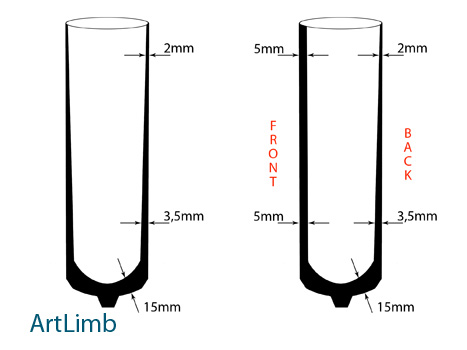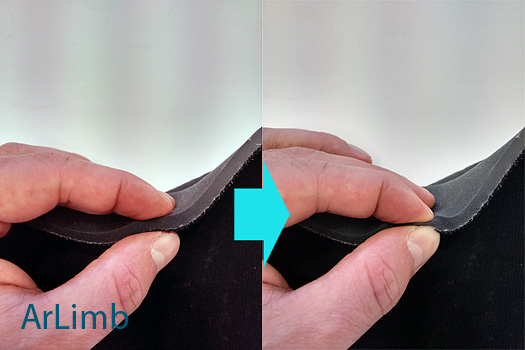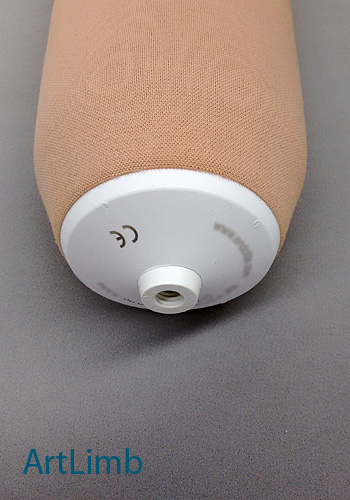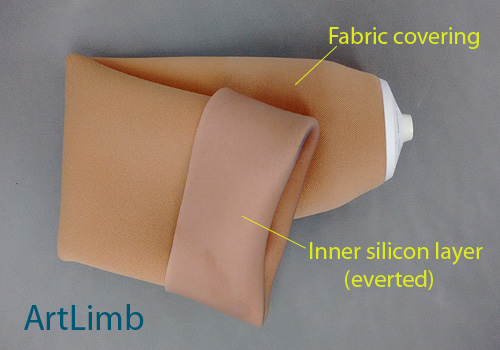Liners come in many shapes, sizes, thicknesses and materials. They tend to be more commonly grouped as Silicon, Gel PolyStyrene and Gel PolyUrethane. All of these materials adhere to the skin when donned forming a secure bond between the surface of the stump and the liner. This totally removes movement between the skin and the liner, protecting from rubbing and chaffing.
Liner shapes
Typically these liners are made in a cylindrical shape but they can also be conical or custom made to fit different stump shapes.
The diagram above demonstrates the difference between cylindrical, conical and custom shapes of liners.
In addition to different shapes, liners can have different thicknesses to protect different areas of the stump. Some even vary the thickness from the bottom to the top or from the front to the back. This is particularly beneficial when protecting prominent bones lower on the stump while reducing the thickness of material behind the knee when sitting.
For example, a thicker Silicon liner will provide more stability in general than a thinner one and a thicker Gel liner will provide more cushioning effects than a thinner one.
The diagram above demonstrates possible different wall thicknesses of liners.
Materials differences
Silicon liners have a high level of stability due to the relative firmness of the material. This helps to protect the bottom of the stump from feeling overstretched in patients with extra soft tissue or people who are very active. This stability comes at a cost however! Silicon does not compress very well which provides less cushioning than other liner materials. We usually accommodate for this in the socket design by adding a soft inner socket made from cushioning foam.
Gel PolyStyrene liners have a high level of cushioning and are usually thicker than silicon liners. This cushioning protects bony and scarred areas of the stump. When the gel is loaded, it gently compresses providing the cushioning effect and when the load is removed, the gel immediately returns to its original shape. To achieve this effect, the gel liner needs to be more mobile (less stable) than the silicon liner. This can be a disadvantage for people with excessive/mobile soft tissue.
The photo above shows a compressed 6mm PolyStyrene liner. It is visible how compressible the gel is.
Gel PolyUrethane liners have an interesting quality in that it is able to flow from the loaded areas to unloaded areas during walking. When the gel is loaded, it gradually compresses and does not restore its original shape immediately. The benefit of this is that during walking, pressure from bony parts of the stump creates relief areas in the gel which maintains a close fit throughout the day.
Further Design Ideas
Silicon and gel compounds on their own are quite flexible and stretchable, therefore additional materials are added to them to improve their durability, ease of donning and reduce overstretching. For example;
* To maintain the distal shape of a locking liner some models have a distal plastic/metal cap (called an umbrella).
* To reduce overstreatching, some liners have an inner fabric (matrix) embedded in the compound or outer fabric covering.
The photo above demonstrates a plastic (white) distal umbrella. In the centre of this umbrella there is a threaded part for attaching pins, lanyards etc.
The photo above demonstrates a liner with a fabric covering. This improves the donning process by allowing the relatively sticky compound to glide over itself.
Some liners have extra substances (Aloe Vera and mineral oils etc) added to the original gel or silicon compound to improve skin condition. Sometimes silver is also added to provide an anti-bacterial effect.
Read Liners: Part1. General Idea – Fixation⇒





